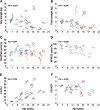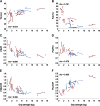Longitudinal functional and NMR assessment of upper limbs in Duchenne muscular dystrophy
- PMID: 26888987
- PMCID: PMC4799716
- DOI: 10.1212/WNL.0000000000002464
Longitudinal functional and NMR assessment of upper limbs in Duchenne muscular dystrophy
Abstract
Objective: To explore the value of nuclear magnetic resonance (NMR) and functional assessments for follow-up of ambulatory and nonambulatory patients with Duchenne muscular dystrophy (DMD).
Methods: Twenty-five 53-skippable patients with DMD were included in this study; 15 were nonambulatory at baseline. All patients underwent clinical and functional assessments every 6 months using the Motor Function Measure (MFM), hand grip and key pinch strength, MoviPlate, and NMR spectroscopy and imaging studies.
Results: Upper limb distal strength decreased in nonambulatory patients over the period of 1 year; ambulatory patients showed improvement during the same period. The same applied for several NMRS indices, such as phosphocreatine/adenosine triphosphate, which decreased in older patients but increased in younger ambulatory patients. Fat infiltration in the upper limbs increased linearly with age. Almost all NMR and functional assessment results correlated.
Conclusions: Our results underscore complementarity of functional and NMR assessments in patients with DMD. Sensitivity to change of various indices may differ according to disease stage.
© 2016 American Academy of Neurology.
Figures


References
-
- Lowes LP, Alfano LN, Crawfis R, et al. Reliability and validity of active-seated: an outcome in dystrophinopathy. Muscle Nerve 2015;52:356–362. - PubMed
-
- Mayhew A, Mazzone ES, Eagle M, et al. Development of the performance of the upper limb module for Duchenne muscular dystrophy. Dev Med Child Neurol 2013;55:1038–1045. - PubMed
-
- Servais L, Deconinck N, Moraux A, et al. Innovative methods to assess upper limb strength and function in non-ambulant Duchenne patients. Neuromuscul Disord 2013;23:139–148. - PubMed
Publication types
MeSH terms
LinkOut - more resources
Full Text Sources
Other Literature Sources
